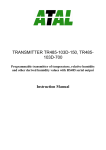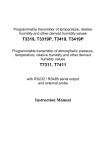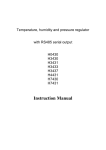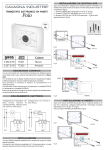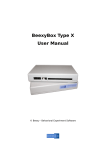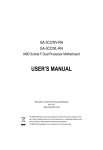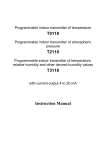Download Master 102D Instruction manual
Transcript
TRANSDUCER TE232-102D, TE485-102D Programmable temperature transducer for RTD Pt1000 sensor with serial output RS232 and RS485 Instruction manual Instruction Manual for use of transducer: TE232-102D (RS232), TE485-102D (RS485) Transducer is designed for temperature measurement at °C or °F by means of the external temperature probe with RTD Pt1000 sensor. It is built in a plastic case with the IP65 protection. Read this manual before the first transducer connection. Transducer TE232-102D communicates via link RS232, transducer TE485-102D via link RS485. Supported communication protocols are Modbus RTU, protocol compatible with standard Advantech-ADAM and ARION. Measured value is displayed on dual line LCD display. Display can be also switched OFF. Output link RS485 of transducer TE485-102D is galvanic isolated. Output link RS232 of transducer TE232-102D is NOT galvanic isolated. Please read instruction manual before the first device connection. Use user’s software Tsensor for setting of all device parameters (recommended). It supports make the adjustment of the device too. This procedure is described at file „Calibration manual.pdf“ which is installed commonly with the software. Change of some parameters is possible to do without user’s software with Windows hyperterminal (change of communication protocol, its parameters, LCD display setting). Transducer setting from the manufacturer If special setting was not required in the order, transducer is set from the manufacturer to the following parameters: communication protocol: transducer address: communication speed: display: Modbus RTU 01H 9600Bd, no parity, 2 stop bits switched ON Transducer installation Transducer is designed for wall mounting. There are two mounting holes at the sides of the case. Don’t connect transducer while power supply voltage is on. Interconnection terminals are accessible after unscrewing four screws and removing the lid. Lace the cable through a gland at the case wall. Connect the cable to terminals with respecting the signal polarity (see figure). Terminals are self-clamping and can be opened by a suitable screwdriver. For the opening, insert the screwdriver to smaller terminal hole and lever by him. Do not forget to tighten glands and case lid with inserted packing after cables connecting. It is necessary for warranting of protection IP65. Working position is negligible. External temperature probe should be of „shielded two-wire“ type. For leading of the cable same recommendations are valid as for current loop cable, i.e. cable should be located as far as possible from potential interference sources. Maximum probe cable length is 10 m. Connect probe cable shielding to proper terminal and do not connect it to any other circuitry and do not ground it. If connected probe is equipped with metal stem, we recommend to use probes with metal stem not connected to cable shielding. Or else it is necessary to arrange metal stem is not connected to any other circuitry. Transducer TE232-102D is supplied with connection cable equipped with connector for connection to RS232 interface. For TE485-102D transducer (RS485) it is recommended to use shielded twisted copper cable (e.g. SYKFY ). Outside diameter of the cable must be from 3 to 6.5 mm, maximal length 1200m. The cable must be located at indoor rooms. Nominal cable impedance should be 100 Ω, loop resistance max. 240 Ω, cable capacity max. 65 pF/m. Suitable cable is e.g. SYKFY 2x2x0,5 mm2, where one wire pair serves for transducer powering and the other pair for communication link. 2 The cable should be led in one line, i.e. NOT to „tree“ or „star“. Termination resistor should be located at the end. For short distance other topology is allowed. Terminate the network by a termination resistor. The value of the resistor is recommended about 120 Ω. For short distance termination resistor can be left out. The cable should not be led in parallel along power cabling. Safety distance is up to 0.5 m, otherwise undesirable induction of interference signals can appear. Electrical system (wiring) may do only worker with required qualification by rules in operation. Dimensions TE232-102D – RS232 TE485-102D – RS485 3 Typical application wiring, connection of terminals TE232-102D – power from communication TE232-102D – power from external voltage port source TE485-102D – RS485 4 Info mode If in doubt of setting of installed transducer, verification of its address is enabled even without using computer. Power should be connected. Unscrew transducer cover and shortly press button next to connection terminals (jumper must be open). Actual adjusted address of transducer is displayed at decimal code. Next press of button exits info mode and actual measured values are displayed. Note: No measurement and communication is possible during info mode. If transducer stays in info mode for longer than 15 s, transducer automatically returns to measuring cycle. Description of communication protocols Detailed description of each communication communication is available in individual document. protocols including examples of Note: After switching ON the power of the device it can last up to 2 s before the device starts to communicate and measure! Modbus RTU Control units communicate on master-slave principle in half-duplex operation. Only master can send request and only addressed device responds. During sending of request no other slave station should respond. During communication, data transfer proceeds in binary format. Each Byte is sent as eight bit data word in format: 1 start bit, data word 8 bit (LSB first), 2 stop bits1, without parity. Transmitter supports communication speed from 110Bd to 115200Bd. Sent request and response have syntax: ADDRESS OF DEVICE – FUNCTION – Modbus CRC Supported functions 03 (0x03): Reading of 16-bit registers (Read Holding Registers) 04 (0x04): Reading of 16-bit input gates (Read Input Registers) 16 (0x10): Setting of more 16-bit registers (Write Multiple Registers) Jumper and button Jumper and button are located next to connection terminals. If communication protocol Modbus is selected the function of jumper and button is as follows: • Jumper opened – transmitter memory is protected from writing, from transmitter side it is only enabled to read measured value, writing to memory is disabled (no change of transmitter address, communication speed and LCD setting is enabled) • Jumper closed – writing to transmitter memory is enabled by means of User’s software • Jumper closed and button pressed for longer than six seconds – causes restoring of manufacturer setting of communication protocol, i.e. sets Modbus RTU communication protocol, device address sets to 01h and communication speed to 9600Bd (after button press there is “dEF” message blinking at LCD display. Six seconds later message “dEF” stays shown, it means manufacturer setting of communication protocol is done). • Jumper opened and button shortly pressed – transmitter goes to Info mode, see chapter „Info mode“ 1 Transmitter sends two stop bits, for receive one stop bit is enough. 5 Modbus registers of the device Variable Unit AddressX Format Size Status Measured temperature [°C] 0x0031 Int*10 BIN16 R Address of transmitter [-] 0x2001 Int BIN16 R/W* Code of communication speed [-] 0x2002 Int BIN16 R/W* Serial number of transmitter Hi [-] 0x1035 BCD BIN16 R Serial number of transmitter Lo [-] 0x1036 BCD BIN16 R Version of Firmware Hi [-] 0x3001 BCD BIN16 R Version of Firmware Lo [-] 0x3002 BCD BIN16 R Explanation: • Int*10 register is in format integer*10 • R register is designed only for reading • W* register is designed for writing, for more details see chapter description of communication protocols • X register addresses are indexed from zero – register 0x31 is physically sent as value 0x30, 0x32 as 0x31 (zero based addressing) Note: In case there is a need for reading of measured values from transmitter with higher resolution than one decimal, measured values in transmitter are stored also in „Float“ format, which is not directly compatible with IEEE754. Protocol compatible with Advantech-ADAM standard Control units communicate on master-slave principle in half-duplex operation. Only master can send requests and only addressed device responds. During sending request any of slave devices should respond. During communication data is transferred in ASCII format (in characters). Each Byte is sent as two ASCII characters. Transmitter supports communication speed from 1200Bd to 115200Bd, parameters of communication link are 1 start bit + eight bit data word (LSB first) + 1 stop bit, without parity. Jumper Jumper is located next to connection terminals. If communication protocol compatible with standard Advantech-ADAM is selected, its function is the following: • If jumper during switching ON the power is closed, transmitter always communicates with following parameters regardless stored setting in the transmitter: communication speed 9600 Bd, without check sum, transmitter address 00h • If jumper during switching ON the power is not closed, transmitter communicates in accordance with stored setting. • If jumper is closed during transmitter operation, transmitter temporarily changes its address to 00h, it will communicate in the same communication speed as before closing jumper and will communicate without check sum. After jumper is opened setting of address and check sum is reset in accordance with values stored in transmitter. • Communication speed and check sum are possible to change only if jumper is closed. • Jumper closed and button pressed for longer than six seconds – causes restoring of manufacturer setting of communication protocol, i.e. sets Modbus RTU communication protocol, device address sets to 01h and communication speed to 9600Bd (after button press there is “dEF” message blinking at LCD display. Six seconds later message “dEF” stays shown, it means manufacturer setting of communication protocol is done). 6 ARION communication protocol - AMiT company The device supports communication protocol ARiON version 1.00. For more details see www.amit.cz. Error states of the device Device continuously checks its state during operation. In case error is found LCD displays corresponding error code: Error 0 First line displays „Err0“. Check sum error of stored setting inside device’s memory. This error appears if incorrect writing procedure to device’s memory occurred or if damage of calibration data appeared. At this state device does not measure and calculate values. It is a serious error, contact distributor of the instrument to fix. Error 1 Measured value is over upper limit of allowed full scale range. There is a reading „Err1“ on LCD display. This state appears if measured temperature is higher than approximately 600°C (i.e. high non-measurable resistance of temperature sensor, probably opened circuit). Error 2 There is a reading „Err2“ on LCD display. Measured value is below lower limit of allowed full scale range. This state appears if measured temperature is lower than approximately -210°C (i.e. low resistance of temperature sensor, probably short circuit). Error 3 There is a reading „Err3“ on LCD display upper line. Error of internal A/D converter appeared (converter does not respond, probably damage of A/D converter). No measurements proceed. It is a serious error, contact distributor of the instrument. Readings on LCD display °C, °F Reading next to this symbol is measured temperature or error state of value. symbol 3 near by left display margin Is on if jumper is closed. 7 Technical parameters of the instrument: RS 485 Interface: Receiver-Input Resistance: 96 kΩ Devices on bus: max. 256 (1/8 Unit Receiver Load) Measuring parameters: Temperature probe: Pt1000/3850 ppm connected by shielded cable of maximum length 10m Measuring temperature range: -200 to +600 °C (can be limited by applied temperature probe model) Resolution: 0.1 °C Accuracy (without probe): ±0.2 °C Recommended calibration interval: 2 years Measuring interval and LCD display refresh: 0.5 s Power: 9 to 30 V dc Protection: IP65 Operating conditions: Operating temperature range: -30 to +80 °C, over +70°C switch LCD display OFF Operating relative humidity range: 0 to 100 %RH Outer influence in accordance with EN 33-2000-3: normal environment with those specifications: AE1, AN1, AR1, BE1 Working position: negligible Electromagnetic compatibility: complies EN 61326-1 Not allowed manipulation It is not allowed to operate the device under conditions other than specified in technical parameters. Devices are not designed for locations with chemically aggressive environment. Storing conditions: temperature -30 to +80 °C, humidity 0 to 100 %RH without condensation Dimensions: case with electronics 89 x 73 x 37 mm Weight: approximately 200 g Material of the case: ABS End of operation Device itself (after its life) is necessary to liquidate ecologically! Technical support and service Technical support and service is provided by distributor. For contact see warranty certificate. 8 Appendix A Connection of ELO E06D converter (RS232/RS485) (optionally accessory of the transducer TE485-102D) The ELO E06D converter is an optional accessory for connection of transducer/transducers with RS485 interface to the PC via serial port RS232. Connect connector marked RS232 directly to the PC, connect power to connector marked RS485. Power voltage +6V DC from an external acdc adapter connect to pin 9, 0V connect to pin 5. Also mutually connect pin 2 and pin 7. Link RS485 is connected across pin 3 (A+) and pin 4 (B-). 9 Notes: 10 Notes: 11











